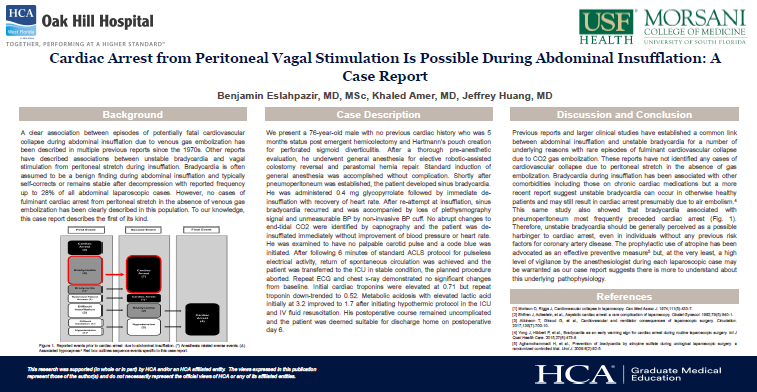2020 FSA Posters
P008: CARDIAC ARREST FROM PERITONEAL VAGAL STIMULATION IS POSSIBLE DURING ABDOMINAL INSUFFLATION: A CASE REPORT
Benjamin Eslahpazir, MD; Khaled Amer, MD; Jeffrey Huang, MD; HCA Healthcare/USF COM GME/Oak Hill Hospital
BACKGROUND: A clear association between episodes of potentially fatal cardiovascular collapse during abdominal insufflation due to venous gas embolization has been described in multiple previous reports since the 1970s. Other reports have described clear associations between unstable bradycardia and vagal stimulation from peritoneal stretch during insufflation. Bradycardia is often assumed to be a benign finding during abdominal insufflation and typically self-corrects or remains stable after decompression with reported frequency up to 28% of all abdominal laparoscopic cases. However, no cases of fulminant cardiac arrest from peritoneal stretch in the absence of venous gas embolization has been clearly described in this population. To our knowledge, this case report describes the first of its kind.
CASE PRESENTATION: We present a 76-year-old male with no previous cardiac history who was 5 months status post emergent hemicolectomy and Hartmann’s pouch creation for perforated sigmoid diverticulitis. After a thorough pre-anesthetic evaluation, he underwent general anesthesia for elective robotic-assisted colostomy reversal and parastomal hernia repair. Standard induction of general anesthesia was accomplished without complication. Shortly after pneumoperitoneum was established, the patient developed sinus bradycardia. He was administered 0.4 mg glycopyrrolate followed by immediate de-insufflation with recovery of heart rate. After re-attempt at insufflation, sinus bradycardia recurred and was accompanied by loss of plethysmography signal and unmeasurable BP by non-invasive BP cuff. No abrupt changes to end-tidal CO2 were identified by capnography and the patient was de-insufflated immediately without improvement of blood pressure or heart rate. He was examined to have no palpable carotid pulse and a code blue was initiated. After following 6 minutes of standard ACLS protocol for pulseless electrical activity, return of spontaneous circulation was achieved and the patient was transferred to the ICU in stable condition, the planned procedure aborted. Repeat ECG and chest x-ray demonstrated no significant changes from baseline. Initial cardiac troponins were elevated at 0.71 but repeat troponin down-trended to 0.52. Metabolic acidosis with elevated lactic acid initially at 3.2 improved to 1.7 after initiating hypothermic protocol in the ICU and IV fluid resuscitation. His postoperative course remained uncomplicated and the patient was deemed suitable for discharge home on postoperative day 6.
CONCLUSIONS: This is an original case report which is the first of its kind to identify a direct link between vagal stimulation and cardiac arrest during peritoneal stretch from intraabdominal insufflation. Previous reports and larger clinical studies have established a common link between abdominal insufflation and unstable bradycardia for a number of underlying reasons with rare episodes of fulminant cardiovascular collapse due to CO2 gas embolization. These reports have not identified any cases of cardiovascular collapse due to peritoneal stretch in the absence of gas embolization. We believe this case report to be the first of its kind and suggests there is more to understand about this pathophysiology.

